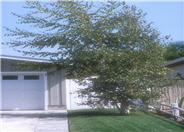
Common name:Chinese Pistache
Botanical name:Pistacia chinensis
The Pistacia chinensis is a deciduous tree with broad, spreading growth to 50' in height. Its leaves have 10-16 leaflets, and the fall coloring arrives in beautiful shades of red, orange and yellow. Prune young trees to shape. This tree does not have edible nuts. Female trees have tiny red fruit, turning dark blue. It prefers full sun and deep, infrequent waterings. This is a great street or park tree.

Common name:Red-Leaf or Fraser Photinia
Botanical name:Photinia X fraseri
The Photina X fraseri is an evergreen, medium-sized shrub with new foliage that is a glistening, copper red color. It is excellent as a hedge, screen, or accent plant. It should be grown under conditions of sun.

Common name:Creeping St. Johnswort, Aaron's Bea
Botanical name:Hypericum calycinum
Hypericum calycinum is an evergreen perennial. Grows 1' high and 1'-2' in spread, and spreads by underground runners. Produces yellow flowers.

Common name:European White Birch
Botanical name:Betula pendula
This medium-size weeping tree will grow to about 40' tall and has a whitish-brown bark with deciduous green leaves.

Common name:Tobira
Botanical name:Pittosporum tobira
This large, dense, evergreen shrub or small tree has shiny dark green leaves. In the spring, clusters of small, cream-colored flowers appear with the fragrance of orange blossoms. Mock Orange can be grown in full sun or partial shade. It is considered one of the most durable shrubs in California landscapes.
Putting the right plants in the right places in the right groupings is both the challenge and art of good landscape design.
Click in the green box for more information
Designer:
Photographer: GardenSoft
Incorporate compost 6" into your soil to retain water, reduce compaction, feed earthworms, and provide valuable nutrients to your plants.
Attract, or buy beneficial insects such as ladybugs and lacewings to control pest outbreaks in your garden.